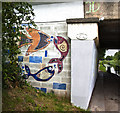
There is a bridge here which takes pedestrian traffic over the canal.
| Ford Narrows | 7 furlongs | |
| Ford Winding Hole | 6¼ furlongs | |
| Gorsey Lane Bridge No 4A | 3¾ furlongs | |
| St. Bernard's Drive Pipe Bridge | 1¼ furlongs | |
| Swift's Lane Bridge No 5 | a few yards | |
| Swift's Lane Footbridge | ||
| Fleetwood's Bridge No 5A | 2 furlongs | |
| Netherton Swing Bridge No 6 | 6¼ furlongs | |
| Copy Bridge No 7 | 1 mile, 1 furlong | |
| Dunnings Bridge No 7A | 1 mile, 2½ furlongs | |
| Old Roan Railway Bridge No 7C | 1 mile, 5 furlongs | |
Amenities nearby at Fleetwood's Bridge No 5A
Why not log in and add some (select "External websites" from the menu (sometimes this is under "Edit"))?
Mouseover for more information or show routes to facility
Nearest water point
In the direction of Wigan Junction
In the direction of Eldonian Village
Nearest rubbish disposal
In the direction of Wigan Junction
In the direction of Eldonian Village
Nearest chemical toilet disposal
In the direction of Wigan Junction
In the direction of Eldonian Village
Nearest place to turn
In the direction of Wigan Junction
In the direction of Eldonian Village
Nearest self-operated pump-out
In the direction of Eldonian Village
Nearest boatyard pump-out
In the direction of Wigan Junction
Wikipedia has a page about Swift's Lane Footbridge
The swifts are a family, Apodidae, of highly aerial birds. They are superficially similar to swallows, but are not closely related to any passerine species. Swifts are placed in the order Apodiformes with hummingbirds. The treeswifts are closely related to the true swifts, but form a separate family, the Hemiprocnidae.
Resemblances between swifts and swallows are due to convergent evolution, reflecting similar life styles based on catching insects in flight.
The family name, Apodidae, is derived from the Greek ἄπους (ápous), meaning "footless", a reference to the small, weak legs of these most aerial of birds. The tradition of depicting swifts without feet continued into the Middle Ages, as seen in the heraldic martlet.


![Weathered bench mark on Swift's Lane Bridge. This weathered bench mark first appears on Swift's bridge in 1893 and disappears from the maps after 1939. The bridge was originally Moss Side Bridge and carried Moss Lane over the Leeds-Liverpool canal. Before 1893 the bridge name changed to Swift's Bridge, and then the lane name was changed to Swift's Lane after 1955. See also [[5658404]] by John S Turner – 15 August 2017](https://s0.geograph.org.uk/geophotos/05/65/83/5658396_619c03bb_120x120.jpg)


![Swift's Bridge #5 over the Leeds-Liverpool Canal. The north east side of Swift's Bridge, which carries Swift's Lane over the Leeds-Liverpool Canal. There is an Ordnance Survey bench mark on the stone next to the towpath - [[5658396]] This weathered bench mark first appears on Swift's bridge in 1893 and disappears from the maps after 1939. The bridge was originally Moss Side Bridge and carried Moss Lane over the Leeds-Liverpool canal. Before 1893 the bridge name changed to Swift's Bridge, and eventually the lane name was changed to Swift's Lane after 1955. by John S Turner – 15 August 2017](https://s0.geograph.org.uk/geophotos/05/65/84/5658404_3bdf7c45_120x120.jpg)
![Swift's Bridge [no 5] from the south-west. Carrying Swifts Lane over the Leeds & Liverpool canal. by Christine Johnstone – 27 May 2021](https://s0.geograph.org.uk/geophotos/06/90/00/6900032_23272bd9_120x120.jpg)
![Swift's Bridge [no 5], from the north-east. Carrying Swifts Lane over the Leeds & Liverpool Canal. Now with a separate footbridge. by Christine Johnstone – 25 May 2021](https://s3.geograph.org.uk/geophotos/06/89/81/6898123_e9fa5667_120x120.jpg)























